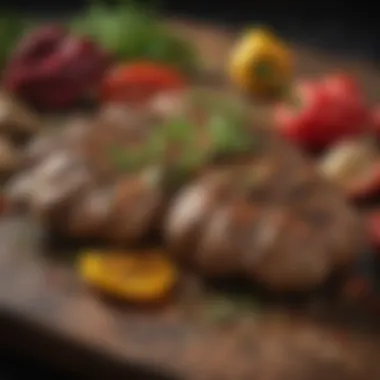Exploring the Rich History of Jerk Chicken Seasoning


Intro
Jerk chicken seasoning represents a profound culinary tradition rooted in the vibrant culture of Jamaica. It embodies a complex interplay of spices, heat, and smokiness that enhances the natural flavors of chicken and other meats. The origins of jerk can be traced back to the indigenous Taíno people, later enriched by African influences, creating a multi-layered flavor profile that is both unique and versatile.
The seasoning typically consists of a variety of key ingredients, from allspice and Scotch bonnet peppers to thyme and garlic. Mastering the art of jerk chicken seasoning not only allows for the preparation of a delicious meal but also offers insight into the rich narrative of Caribbean cuisine. The importance of this seasoning in culinary applications cannot be overstated, as it is not limited to chicken alone but can be adapted for seafood, pork, and even vegetables, thus catering to a wide array of dietary preferences.
Within this article, we will explore not just the fundamentals of jerk chicken seasoning, but also its historical context, preparation methods, and regional variations. Each section is designed to enrich your understanding, offering both theoretical and practical knowledge for cooks and food enthusiasts alike.
Understanding the Essence of Jerk Chicken
Jerk chicken is not just a dish; it is a cultural phenomenon that encapsulates a rich heritage of flavor, tradition, and identity. Understanding the essence of jerk chicken involves delving into its historical origins and its crucial role in Caribbean cuisine. This section sets the stage for appreciating the complexities of jerk chicken seasoning, as it intertwines history, culture, and culinary artistry.
Historical Background
The origins of jerk chicken can be traced back to the indigenous Taíno people, who inhabited Jamaica long before European colonization. They utilized various spices and cooking methods that laid the groundwork for what would become the jerk style of cooking. Later, enslaved Africans adapted and transformed these traditions using local ingredients. The name "jerk" itself derives from the Spanish word "charqui," which refers to dried or preserved meat. This historical context highlights how jerk chicken emerged as a survival method, utilizing the spices and techniques available to enslaved individuals.
Over the centuries, jerk seasoning evolved, reflecting the diverse influences of the Caribbean. Today, it is regarded as a hallmark of Jamaican cuisine and has garnered global recognition.
Cultural Significance in Caribbean Cuisine
Jerk chicken holds a special place in Caribbean gastronomy. It is often associated with communal gatherings, celebrations, and family dinners. The preparation of jerk chicken often becomes a social event, where families and friends come together to rub and marinate the chicken before cooking. This process symbolizes unity and shared traditions.
Moreover, jerk seasoning represents a fusion of cultures, blending African, indigenous, and European culinary practices. The ingredients used, such as allspice, thyme, and Scotch bonnet peppers, are not only vital for flavor but also hold significance in local traditions.
The cultural importance of jerk chicken extends beyond just food. It is featured in festivals, music, and art, serving as a source of pride for Jamaican and Caribbean communities. As more people become acquainted with this culinary tradition, jerk chicken continues to evolve while remaining a cherished symbol of the region's identity.
Defining Jerk Chicken Seasoning
Defining jerk chicken seasoning is central to understanding its role in Caribbean cooking. Jerk chicken seasoning differentiates itself through unique combinations of spices and ingredients that reflect cultural history and culinary craftsmanship. By grasping its definition, one appreciates not just its flavor but also the techniques involved in preparation. This is essential knowledge for both experienced chefs and home cooks eager to explore true Jamaican cuisine. The seasoning plays a crucial role in creating depth and authenticity in jerk chicken, making it more than just a flavor profile; it is a culinary tradition.
Primary Ingredients
Allspice
Allspice is a cornerstone of jerk chicken seasoning. This spice provides a warm and aromatic flavor. The key characteristic of allspice is its complex profile, reminiscent of cinnamon, nutmeg, and clove all at once. Its unique feature is that it ties together the various flavors present in jerk seasoning, contributing to its depth. Moreover, its ability to enhance the overall taste makes allspice a popular choice in the blend.
Thyme
Thyme brings a fresh, earthy note to jerk chicken seasoning. It is especially valued for its strong and pleasant flavor. The key characteristic of thyme is that it complements the heat of Scotch bonnet peppers without overwhelming it. Its unique feature is its ability to create balance, which is critical in achieving authentic jerk seasoning. However, using too much thyme can result in a slightly bitter taste, which is a consideration to keep in mind.
Scotch Bonnet Peppers
Scotch bonnet peppers are known for their significant heat and fruity flavor. This pepper is essential for the traditional spiciness of jerk chicken. The key characteristic of Scotch bonnet peppers is their high Scoville rating, which makes them one of the hottest peppers available. Their unique feature is that they assert a vibrant flavor that brightens the dish while delivering heat. One downside is that not everyone can tolerate the same level of heat, making this a strong consideration for caterers and home cooks who cater to varying taste preferences.
Secondary Flavor Components
Garlic
Garlic adds a pungent and savory element to jerk chicken seasoning. Its robust flavor profile enhances the overall mix. The key characteristic of garlic is its ability to elevate simple dishes through depth of flavor. Its unique feature is its versatility; it can be used fresh or powdered. However, caution is necessary, as an abundant garlic amount can overpower the other ingredients.
Ginger
Ginger provides a sharp and zesty note to jerk seasoning. This root has warm and spicy flavor, making it a well-liked component. The key characteristic of ginger is its fresh, slightly sweet taste that aids in the overall seasoning balance. Its unique feature is that it can offer digestive benefits, adding a healthy edge to the dish. That said, overuse can lead to a dish that tastes excessively sharp, overshadowing other flavors.
Brown Sugar
Brown sugar introduces sweetness that balances the heat from the peppers. It has a caramel-like flavor that enriches the overall mix. The key characteristic of brown sugar is its moisture content, which can help enhance the marinade’s texture. Its unique feature is how it can caramelize when cooked, contributing to a lovely outer crust on the chicken. However, if too much is added, it might make the dish overly sweet, so moderation is key.
The Science of Flavor in Jerk Seasoning
Understanding the science behind flavor in jerk seasoning is crucial for achieving a balanced and authentic taste. Flavor is a multi-faceted experience, influenced by various components that interplay within the seasoning. In jerk chicken seasoning, this complexity arises not only from the ingredients themselves but also from how they interact during the cooking process. By focusing on specific elements such as heat, sweetness, acidity, and the role of aromatics, cooks can create a holistic and satisfying culinary experience.
Balancing Heat and Sweetness
Heat and sweetness are two fundamental pillars of jerk seasoning. The combination of these contrasting flavors creates depth and enhances the overall tasting experience. Scotch Bonnet peppers, known for their intense heat, provide the spice that is emblematic of jerk seasoning. On the other hand, brown sugar introduces a natural sweetness that counters the fiery notes.
Achieving balance requires skill. Too much heat can overpower the dish, while excessive sweetness may dilute the intended flavor. A general rule of thumb is to start with a respected ratio of heat to sweetness, adjusting based on personal preference. The key ingredients should complement rather than compete.
Some cooks prefer to add honey or even maple syrup as an alternative to brown sugar. This flexibility allows for personal interpretation while adhering to the core principle of balance.
Role of Acidity and Aromatics
Acidity plays a vital role in elevating jerk chicken seasoning. Ingredients like lime juice or vinegar not only contribute zest but also help tenderize the meat. This reaction breaks down proteins, leading to a more succulent final product. The balance of acid can further enhance the perception of flavors, making them more vibrant on the palate.


Aromatic components, such as thyme and garlic, add complexity and richness to the mix. These herbs and spices lend character to jerk seasoning, imparting earthiness and depth that round out the flavor profile.
Incorporating these elements enhances the seasoning. A well-crafted jerk seasoning harmonizes heat, sweetness, and acidity to create an unforgettable culinary experience. To understand how to best combine these aspects, experimentation with measurements during the preparation phase can yield the most rewarding results.
"The balance of flavors in jerk seasoning defines its authenticity. Understanding this balance can elevate a culinary experience significantly."
In summary, the science of flavor in jerk seasoning is essential for achieving the authentic taste that characterizes this dish. By mastering the balance of heat and sweetness, as well as understanding the roles of acidity and aromatics, both home cooks and professional chefs can craft remarkable jerk chicken that celebrates its rich heritage.
Preparation and Storage Techniques
Understanding the preparation and storage techniques for jerk chicken seasoning is essential for both chefs and home cooks. The proper preparation enhances flavor, while correct storage maximizes ingredient quality. Knowing how to create and preserve your own jerk seasoning can help you replicate its bold taste whenever needed.
Making Your Own Jerk Seasoning
Methods for Grinding Spices
Grinding spices is a crucial step in making your own jerk seasoning. Freshly ground spices provide a depth of flavor that pre-ground alternatives cannot match. The method of grinding influences the texture and potency of the seasoning.
There are several tools for grinding. A mortar and pestle offers control and can be satisfying to use. However, an electric spice grinder is faster and yields a uniform texture. Each method has its advantages and disadvantages.
Using a mortar and pestle allows for a more traditional approach and lets you release oils from the spices. On the other hand, an electric grinder is convenient for making larger batches quickly.
Selecting Fresh Herbs
Choosing fresh herbs is fundamental in achieving authentic jerk chicken seasoning. Fresh thyme, scallions, and parsley play vital roles in the flavor profile. They add brightness and a fragrant aroma that dried herbs simply cannot replicate.
The vital characteristic of selecting fresh herbs is their impact on flavor intensity. Fresh ones maintain a certain crispness and integrity, whereas dried herbs can lose their essential oils over time.
While fresh herbs may have a shorter shelf life, their vibrant flavors make them worth the investment. Furthermore, local availability often determines what you can easily find, which impacts the final taste of the seasoning.
Storage Recommendations
Shelf Life
Shelf life is an important consideration for the homemade jerk seasoning. Properly stored, your seasoning can last varying durations depending on the ingredients used. Overall, the freshness of your spices and herbs will greatly dictate how long the flavor lasts.
Typically, home-made jerk seasoning lasts about two weeks in the refrigerator. This makes it essential to make smaller batches as needed. Ensuring it is kept in a sealed container helps preserve its quality over time.
Proper Containers
The type of container used for storage can influence the durability of jerk seasoning. Airtight glass jars are the preferred choice, providing a barrier against light and air, both of which can degrade quality.
Glass jars resist leaching, unlike some plastic containers, which can alter the flavor over time. The unique feature of using proper containers is their ability to create an optimal environment for extending shelf life.
A downside to glass jars is their weight and fragility, which might not appeal to everyone. However, investing in the right storage solutions pays off by maintaining the seasoning's vibrancy, which is critical for achieving the ideal jerk chicken flavor.
Regional Variations in Jerk Seasoning
The topic of regional variations in jerk seasoning is critical to understanding the depth and diversity of this beloved culinary tradition. Each Caribbean island contributes its unique touch to the flavors, preparation methods, and overall approach to jerk seasoning. This diversity allows cooks and food enthusiasts to experience a wide range of tastes and textures, elevating jerk chicken beyond a basic recipe to a canvas of cultural expression. Furthermore, recognizing these variations can lead to innovative culinary applications that respect tradition while also embracing modern influences.
Jerk Seasoning from Jamaica
Jamaica is considered the birthplace of jerk seasoning. The traditional Jamaican recipe emphasizes a balance of heat, sweetness, and aromatic flavors. The primary ingredients, such as allspice, thyme, and Scotch bonnet peppers, are often combined with supportive flavors like garlic and ginger. Jamaican jerk spices are traditionally applied as a marinade, allowing for thorough penetration into the meat. This results in an intense flavor profile that reflects the island's vibrant environment.
When preparing Jamaican jerk seasoning, it is essential to use fresh herbs and spices. The authenticity comes from sourcing ingredients like thyme and allspice from local sources. The method often involves marinating the meat for several hours or overnight, ensuring the spices fully integrate. Cooking methods vary from grilling over pimento wood to smoking, contributing distinct smoky notes.
Influences from Other Caribbean Islands
While Jamaica set the standard for jerk seasoning, other Caribbean islands have made their own contributions to this vibrant seasoning style. Each island adapts the core components to local tastes and available resources.
For example, in Trinidad and Tobago, the jerk style often incorporates additional ingredients such as coriander and lime. This gives their jerk seasoning a citrusy brightness that complements the heat of the Scotch bonnet peppers, often resulting in a more refreshing finish compared to traditional Jamaican versions.
Meanwhile, in the Bahamas, jerk seasoning may utilize local peppers and a sweeter blend of spices, offering a unique twist on the classic. Here, jerk chicken is often served with fresh tropical salsas that highlight the island’s abundant fruit.
In other Caribbean nations, jerk seasoning may also reflect influences from indigenous cultures, colonial history, and access to various spice trade routes. As such, the jerking process becomes a communal expression of identity as different cultures interpret heat, spice, and savoriness through their culinary lens.
Indulging in jerk variations from different Caribbean islands allows one to appreciate the full spectrum of flavors this beloved seasoning can offer.
Culinary Applications of Jerk Chicken Seasoning
The culinary applications of jerk chicken seasoning extend beyond its traditional use. Understanding these applications can greatly enhance dish flavors and provide creativity in the kitchen. This seasoning's versatility invites both chefs and home cooks to experiment and adapt it to various ingredients. By exploring marinades, rubs, and even its application in non-chicken dishes, one can fully appreciate the potential of jerk chicken seasoning.
Marinades and Rubs for Chicken


Marinating chicken with jerk seasoning infuses the meat with robust flavors. The marinade not only adds taste but also tenderizes the chicken through the acidity from ingredients like lime juice or vinegar. The balance of heat from scotch bonnet peppers and sweetness from brown sugar creates a rich flavor profile. To make a successful marinade, consider the following key points:
- Select the Right Amount: Using jerk seasoning in appropriate quantities will enhance but not overwhelm the dish.
- Time: Allow the chicken to marinate long enough, usually several hours to overnight. This allows for deeper flavor penetration.
- Cooking Method: Grilling or smoking chicken can elevate its taste, providing that distinct charred flavor that pairs well with jerk seasoning.
Overall, marinades and rubs made with jerk chicken seasoning open the door to flavorful chicken dishes.
Utilizing Jerk Seasoning Beyond Chicken
Apart from being a staple for chicken, jerk chicken seasoning can be applied to a variety of other foods, including pork, vegetables, and seafood. Exploring these options illustrates the versatility of this seasoning.
Pork
The inclusion of pork in jerk recipes adds a delightful twist. Pork’s rich flavor pairs well with the bold taste of jerk seasoning. Because pork has a higher fat content than chicken, it absorbs and retains flavors beautifully. This aspect helps create a juicy and succulent dish. Popular cuts like pork shoulder or tenderloin can be marinated and grilled or roasted. However, it is important to be mindful of cooking times as overcooking can lead to dryness. Thus, pork remains a beloved choice for enhancing the jerk experience.
Vegetables
Jerk seasoning's application to vegetables brings new life to often unseasoned dishes. It is a beneficial choice to elevate dishes filled with slices of bell peppers, eggplant, or zucchini. The heat in the seasoning complements the natural sweetness of the vegetables. Roasting or grilling these vegetables allows for caramelization, enhancing their flavors and resulting in distinct, smoky notes. It is a unique feature that promotes healthful eating while maintaining an enjoyable taste, suitable for various dietary preferences.
Seafood
Seafood can also be a great platform for jerk seasoning. Fish such as snapper or mahi-mahi benefits from the vibrant flavors of the seasoning. Unlike meat dishes, seafood requires a more delicate touch. The cooking time is typically shorter, making it essential to monitor closely to avoid fish becoming too tough. When prepared correctly, the combination of jerk seasoning with seafood creates a fragrant and exciting dish. The lightness of the seafood complements the bold seasoning beautifully, making it a popular, attractive option for many cooks.
Applying jerk chicken seasoning widely showcases its depth and adaptability. From traditional marinades to fresh vegetable sides and delicately prepared seafood, this seasoning can transform diverse dishes into a flavorful experience.
Health Considerations with Jerk Chicken Seasoning
When discussing jerk chicken seasoning, it is essential to address health considerations. This not only enhances the understanding of its culinary value but also informs readers about the nutritional benefits and potential allergens. Knowledge of these aspects helps cooks and food enthusiasts to make informed choices about incorporating jerk chicken seasoning into their diets. This section examines the nutritional profile of key ingredients, as well as potential allergens to watch out for when preparing jerk chicken.
Nutritional Profile of Key Ingredients
The ingredients in jerk chicken seasoning are critical not only for flavor but for their nutritional contributions. Here, we will explore some key components:
- Allspice: Known for its sweet and spicy flavor, allspice is rich in antioxidants. It also contains anti-inflammatory properties, which can be beneficial for overall health.
- Thyme: This herb is low in calories but high in vitamins and minerals, such as Vitamin C and Vitamin A. Thyme is also recognized for its antimicrobial properties.
- Scotch Bonnet Peppers: These peppers are high in Vitamin C and capsaicin. Capsaicin can boost metabolism and elevates mood by releasing endorphins, contributing to a sense of well-being.
- Garlic and Ginger: These ingredients are well-known for their health benefits. Garlic can enhance immune function, while ginger is celebrated for its anti-nausea effects and anti-inflammatory properties.
- Brown Sugar: While often perceived as less healthy due to its sugar content, brown sugar does provide some minerals like calcium and potassium. Moderation is key to balance sweetness with overall health.
The careful selection of these ingredients not only underpins the distinctive flavor of jerk chicken but also offers health benefits that enhance the overall dish.
Potential Allergens
While jerk chicken seasoning boasts a flavorful profile, some ingredients may trigger allergies in certain individuals. Recognizing these allergens can help avoid potential health risks. Key allergens in the seasoning include:
- Peppers: For those allergic to nightshades, Scotch Bonnet peppers can be problematic. Symptoms can range from mild digestive issues to more severe reactions.
- Garlic: Some individuals are sensitive to garlic, leading to reactions like headaches or digestive distress.
- Brown Sugar: While not commonly an allergen, those with dietary restrictions may have concerns regarding sugar intake. Careful consideration is needed for those managing conditions like diabetes.
- Herbs: Some people may have sensitivities to specific herbs used in jerk seasoning, including thyme. However, these reactions are less common.
Serving Suggestions for Jerk Chicken
Serving suggestions for jerk chicken are essential for understanding how to enhance this flavorful dish. The way jerk chicken is paired with various sides can elevate the dining experience. Here, we explore traditional accompaniments and modern interpretations that bring out the seasoning's complexity while satisfying diverse palates.
Traditional Accompaniments
Rice and Peas
Rice and peas is a quintessential pairing for jerk chicken. This dish is actually made with rice and kidney beans, cooked together with coconut milk, scallions, and spices. The combination of creaminess and texture in rice and peas complements jerk chicken's bold flavors. The key characteristic of rice and peas is its subtle sweetness and ease of preparation.
This dish is a beneficial choice for serving with jerk chicken because it absorbs some of the seasoning's heat while providing a hearty base. The traditional methods of cooking allow the rice to take on flavors from the beans, creating richness that balances the spice of the chicken. However, it is important to note that preparing rice and peas can require precise timing to ensure both the rice and beans are cooked to perfection.
Plantains
Plantains are another traditional accompaniment that pairs well with jerk chicken. They can be fried or baked, bringing a sweet element to the plate. The unique feature of plantains is their versatility; they can be served ripe, providing a sweeter taste, or unripe, which can be more savory.
Plantains add a distinct texture that contrasts nicely with the tenderness of jerk chicken. This popular choice adds color and richness to the meal, making it visually appealing. However, cooking plantains requires attention, as overcooking can lead to unappetizing mushiness, which detracts from their contribution to the dish.
Modern Twists on Serving
Tacos
In recent culinary trends, jerk chicken tacos have emerged as an innovative way to enjoy this classic dish. Tacos provide an easy-to-eat format that appeals to various audiences. The key characteristic of jerk chicken tacos is their blend of traditional Caribbean flavors with a modern twist.
This serving option allows for customization—adding ingredients like avocado, salsa, or slaw can enhance freshness and texture. Tacos are beneficial because they make the flavors of jerk seasoning accessible to those who might not yet appreciate Caribbean cuisine fully. However, the challenge lies in balancing the spices so they do not overwhelm the other flavors.
Salads
Serving jerk chicken in the form of salads is another modern approach. This option integrates the spice of the chicken with greens, fruits, and various dressings. The key characteristic of salads is their freshness, often contrasting the bold and smoky flavor of jerk chicken.
This method is a popular choice among health-conscious consumers. Salads allow for a variety of textures and flavors—crunchy vegetables, creamy dressings, and sweet fruit provide a well-rounded dish. However, not everyone may be open to the idea, as the traditionalist may consider it a deviation from the classic serving methods, potentially losing the authentic vibe of the dish.


"Pairing jerk chicken with the right sides is key to creating a balanced meal that highlights the dish's unique flavors and textures."
Common Mistakes to Avoid in Preparing Jerk Chicken
Preparing jerk chicken is as much an art as it is a science. While there are established methods and traditional practices, common mistakes can undermine the authenticity and flavor of this iconic dish. Understanding these pitfalls can enhance the overall cooking experience. Serious enthusiasts and casual cooks alike should be mindful of these missteps, as they can lead to disappointing results, even if the ingredients are top-notch.
Over-Marinating or Under-Marinating
Marinating is a critical step in achieving the bold, complex flavors associated with jerk chicken. However, both over-marinating and under-marinating can detrimentally affect the final outcome.
Over-marinating may sound counterintuitive. It often leads to overpowering flavors that mask the authentic essence of the jerk seasoning. If the chicken is left in the marinade for too long, especially when using acid-based components like lime juice or vinegar, it can lead to a mushy texture. This compromises the meat’s integrity and impacts the overall eating experience.
On the other hand, under-marinating fails to impart enough flavor into the chicken. A short marinating time does not allow the spices to penetrate the meat effectively. The chicken may taste bland and lack the characteristic intensity that authentic jerk dishes are known for. As a guideline, marinating for at least 2 hours, and ideally overnight, can strike the right balance. This offers the meat sufficient time to absorb the spices without becoming overly soft.
Ignoring Cooking Techniques
The cooking method is as essential as the marinade when it comes to preparing jerk chicken. Ignoring proper cooking techniques can lead to undercooked chicken or unwanted dryness.
For instance, traditional jerk chicken is cooked over pimento wood, which imparts a unique smoky flavor. Not using the right cooking method, such as grilling or smoking, can significantly alter the taste profile. If grilling is not possible, baking or pan-searing can work, but the result will not be the same. Investing in a good grill or smoker enhances the depth of flavor.
Another common oversight is improper heat management. Cooking chicken too quickly over high heat can lead to charred skin while leaving the inside undercooked. Conversely, cooking on too low heat may dry out the meat. Monitoring cooking temperatures is crucial for achieving that perfect char while keeping the meat juicy and tender.
Key Takeaway: Focus on the balance of marinating time and follow established cooking techniques to truly relish the complexities of jerk chicken seasoning.
In summary, attentiveness to marinating and cooking methods can make a notable difference in the quality of jerk chicken. Ensuring that the chicken is neither over-marinated nor undercooked are basic yet vital principles. Avoid these common mistakes for a more authentic and satisfying meal.
Jerk Chicken in Popular Culture
Jerk chicken holds a significant place in the culinary landscape, not merely as a dish, but as a cultural icon that transcends the dining table. Its infusion into popular culture highlights the relationship between food and identity, reflecting the rich heritage of the Caribbean. This section explores how jerk chicken has managed to endure and thrive in various media formats and events, contributing to its widespread popularity.
Representation in Media
Across various media channels, jerk chicken is portrayed as more than just food. It symbolizes Caribbean unity, tradition, and resilience. Cookbooks, culinary shows, and social media platforms showcase jerk chicken recipes and techniques, attracting food enthusiasts and curious souls alike. The visibility this dish gains from these platforms often amplifies interest in Caribbean culture, leading to a greater appreciation of its cuisine.
Documentaries and travel shows have also featured jerk chicken, highlighting its roots and variations. For instance, the dish frequently appears in programs focusing on Jamaican culture, providing insight into its preparation and significance. The representation contributes to a broader understanding of Caribbean identity, linking it to themes of heritage and community.
"Food is a powerful connector. Jerk chicken's presence in media strengthens ties between cultures and promotes understanding among diverse communities."
Social media platforms like Instagram and TikTok have seen an explosion of content featuring jerk chicken. Users share recipes, cooking tips, and restaurant recommendations, further embedding the dish into modern culinary discussions. Food bloggers often highlight personal stories relating to jerk chicken, giving readers a more intimate connection to the dish.
Culinary Events Featuring Jerk Chicken
Culinary events have played a vital role in popularizing jerk chicken. Festivals and competitions centered around Caribbean cuisine often feature this flavorful dish, showcasing its versatility and robustness. These events provide a platform for chefs to innovate and experiment with traditional jerk seasoning.
The Jerk Festival, for example, is a notable event celebrating Jamaican culture through food, music, and art. It draws thousands of visitors eager to engage with jerk chicken in its many forms, from classic preparations to modern spins. Such festivals promote not only the dish itself but also the tribes of culture surrounding them.
Local restaurants also partake in culinary competitions focusing on jerk chicken. Chefs compete to create the best version, pushing the boundaries of traditional recipes. This eagerness for competition drives chefs to delve deeper into the nuances of the seasoning, leading to exciting innovations in presentation and flavor balance.
In summary, jerk chicken's appearance in both media and culinary events is significant in understanding its cultural stature. It serves as a gastronomic bridge, linking people and cultures while promoting a broader appreciation for Caribbean culinary traditions. The ongoing engagement with jerk chicken ensures its place in modern culinary discourse, making it an essential subject for food lovers, cooks, and housewives alike.
Future Trends in Jerk Chicken Seasoning
The culinary world is constantly evolving, and jerk chicken seasoning is no exception. As global food trends shift, the adaptation of traditional recipes becomes essential. Understanding the future trends in jerk chicken seasoning is important for both chefs and home cooks. It allows them to stay relevant in a dynamic food landscape and meet changing consumer preferences.
This section will explore two significant future directions: emerging flavor combinations and adaptations for health-conscious consumers. These trends reflect the increasing interest in diverse culinary experiences and the desire for healthier meal options.
Emerging Flavor Combinations
As food enthusiasts explore bold tastes, new combinations with jerk chicken seasoning are gaining popularity. Here, traditional jerk seasoning interacts with various other flavors, creating an exciting range of dishes.
For example, integrating fruits like mango or pineapple can enhance the heat with a sweet touch. The sweetness from these fruits balances the spice, resulting in a more complex flavor profile. Here are some flavor combinations that show promise:
- Coconut and Lemongrass: This pairing offers a fresh, tropical twist.
- Cilantro and Lime: Bright notes can enhance and cut through the spiciness.
- Honey and Balsamic Vinegar: A fusion of sweet and tangy to create a unique glaze.
These combinations make jerk chicken seasoning versatile, appealing to a broader audience while maintaining its core identity.
Adaptations for Health-Conscious Consumers
With growing health awareness, many individuals are seeking ways to enjoy their favorite foods while maintaining a balanced diet. This shift is important for jerk chicken seasoning, which traditionally relies on rich flavors and fats.
Healthier adaptations involve adjusting the ingredient list. Instead of using refined sugars, cooks can use natural sweeteners like agave syrup or maple syrup. Moreover, substituting olive oil for vegetable oil in marinades reduces unhealthy fats without sacrificing flavor. Furthermore, incorporating more vegetables can transform jerk chicken recipes into well-rounded meals.
Practical tips include:
- Utilize lean cuts of chicken like breast or thighs to lower fat content.
- Opt for low-sodium soy sauce to manage salt intake.
- Experiment with baking or grilling instead of frying.
The rejection of overly processed ingredients and the embrace of whole foods reflects the modern culinary ethos.
In summary, the future of jerk chicken seasoning appears promising. By exploring emerging flavor combinations and catering to health-conscious consumers, chefs and cooks can innovate while respecting traditional roots. This evolution keeps jerk chicken relevant and ensures it continues to delight a diverse audience.







